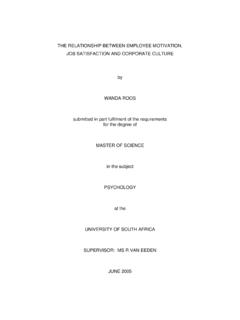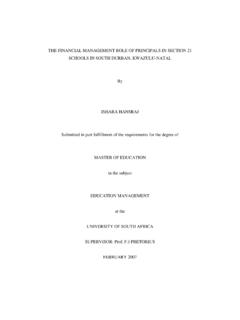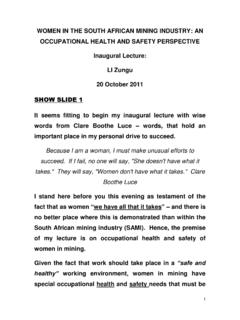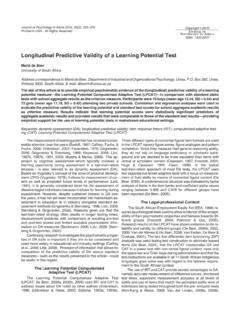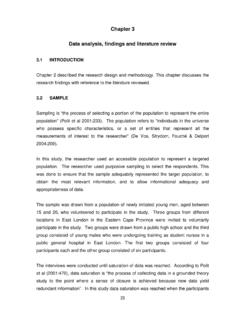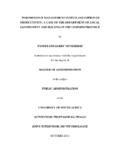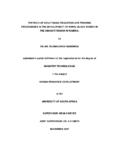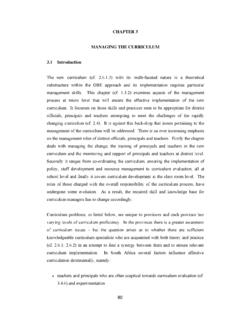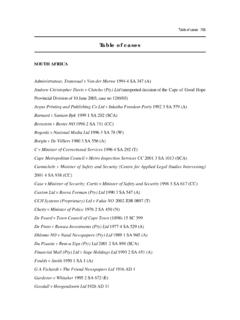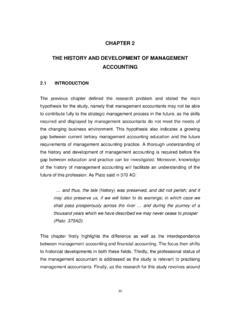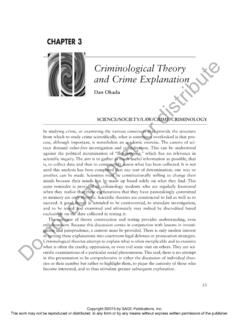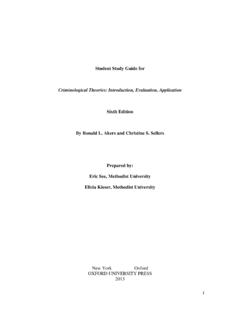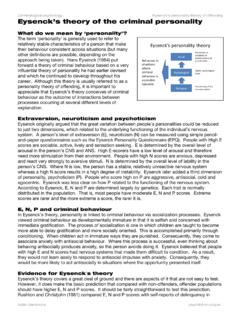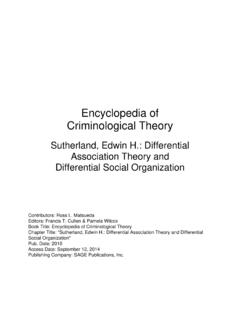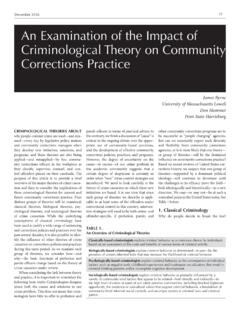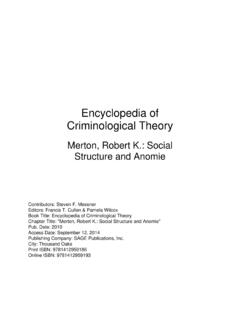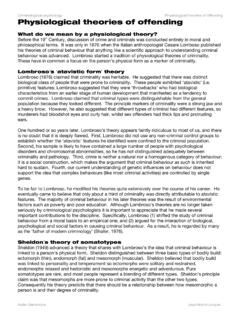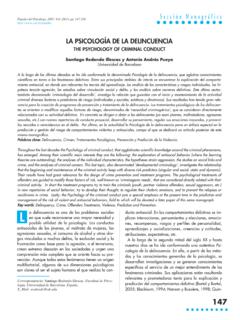Transcription of THEORETICAL EXPLANATION
1 THEORETICAL EXPLANATION : PAGE 155 CHAPTER 6 CHAPTER 6 THEORETICAL EXPLANATIONTHEORETICAL EXPLANATION THEORETICAL EXPLANATION : PAGE 156 INTRODUCTIONINTRODUCTION Having discussed motivational and contributory factors as well as the proximal antecedents and situational contexts in which they occur in the previous chapter, the challenge and focus of the study now shifts towards the identification and development of a THEORETICAL crime causation model that will sufficiently explain conservation crime as it relates to the illegal reptile trade phenomenon.
2 A perusal of the criminological literature pertaining to crime causation theories reveals, however, a legion of, often vastly divergent, perspectives and ideologies, none of which, it is submitted, adequately explain or allow for a full understanding of any particular crime or crime category entirely unaided. This fact, therefore, inter-alia, highlighting the complex and multi-dimensional nature of crime and criminality. An interesting, and at the same time perplexing observation in this regard, is the fact that, whilst approaches are often based on competing assumptions, and therefore diametrically opposed, they can be equally credible and applicable to analogous crime phenomena.
3 Since conservation crime , although unique in many specific ways, in essence shares certain qualities with conventional crime , the explanatory model developed will inevitably gravitate towards a synthesis of plausible fundamental schools of thought that have historically evolved in the criminological discourse and necessarily, therefore, be eclectic in nature. A prerequisite for the tentative EXPLANATION envisaged is, however, that it should, at least, be pragmatic and enrich the THEORETICAL repertoire - serving as a means to an end rather than purporting to be an end in itself. The academic pursuit of criminology and the formulation of criminological dogma can thus be viewed as integral to the development of the discipline, and as the basis for all the activities, which are to be personified in criminal justice.
4 THEORETICAL EXPLANATION : PAGE 157 Bhom (in Brown, Esbensen & Geis 2001:18), states appositely in this regard: theory is the foundation of criminology and the basis of action. Everything done in criminal justice is based on theory , although we are often unaware of the theory on which actions are based. We study theory , then, to know why we are doing what we do. People who are uninterested in (or abandon) theory are people who choose to move blindly through life, or, in the case of criminal justice, intervene in people s lives with only vague notions about why they are doing what they are doing.
5 In order to address the issue of crime causation modelling in a holistic, comprehensive and chronological manner, it is, therefore, considered sensible praxis, to provide a succinct overview of those broad schools of thought, as well as their developmental sequence, that have historically dominated the criminological discourse, as a precursor to this chapter. CLASSIFICATION OF criminological THEORYCLASSIFICATION OF criminological theory Identifying and explaining the processes that cause criminal behaviour are undoubtedly, as alluded to above, of fundamental importance in examining and analysing the crime phenomenon.
6 To explain and understand crime , criminologists have formulated many theories that, at least in their ideal form, are composed of clearly stated propositions that posit relationships, often of a causal sort, between events and things under study (Schmalleger 1996:15), and customarily have their roots in one [or both] of the two major THEORETICAL approaches discussed below. Through the years two central ideologies have evolved by means of which criminologists seek to explain and understand crime and criminality. These two ideologies or schools of thought , namely the classical and positivist schools are, paradoxically, characterised by antithetical assumptions and diverse policy implications.
7 Notwithstanding this obvious and inherent mutual exclusivity, both schools have drawn a wide following and divided support base that essentially remains to this very day. THEORETICAL EXPLANATION : PAGE 158 It is, moreover, not surprising that these unicausal, all inclusive and dogmatic shibboleths have often facilitated the fusion of elements from both schools in order to create THEORETICAL perspectives that more suitably attempt to explain the complex and multi-dimensional phenomenon that is crime and criminality.
8 These two schools have, furthermore, inevitably spawned various derivative explanatory theories/perspectives that are, to a lesser or greater degree, germane to crime aetiology, but which can invariably be linked to the particular disposition and orientation of the criminological initiator/scholar. According to Snyman (1990:18), the history of the development of criminology is assimilated into the changing language of current criminology. Snyman op. cit. asserts that there is no new criminology, as each line of thought is a continuation of previous ideas developed through the centuries.
9 The approach to criminology is, therefore, anything but static, develops with the changing times, and can be said to be as much influenced by history as by current events. The doctrine that characterises each of these schools, their evolutionary/developmental adjuncts as well as certain other more prominent THEORETICAL perspectives will be systematically articulated below, serving as a template for the development of a herpetological crime explanatory model. THE CLASSICAL SCHOOLTHE CLASSICAL SCHOOL The classical school of criminology was established in 1755, and is so called because it was the first (italics mine) attempt to reflect logically and formally on criminology (Snyman 1990:6).
10 The school was founded by Cesare Beccaria and Jeremy Bentham and was developed in response to the primitive and cruel European justice system that existed prior to the French Revolution of 1798 (Glick 1995:710; White & Haines 2001:28); effectively usurping earlier views that crime is a supernatural phenomenon (Brown, et al. 2001:227). THEORETICAL EXPLANATION : PAGE 159 Strangely, and of course most appropriately in the context of this thesis it was, according to South (1998:211), Beccaria himself who once remarked: Do not commit any crime and be just with all the things that surround you.
